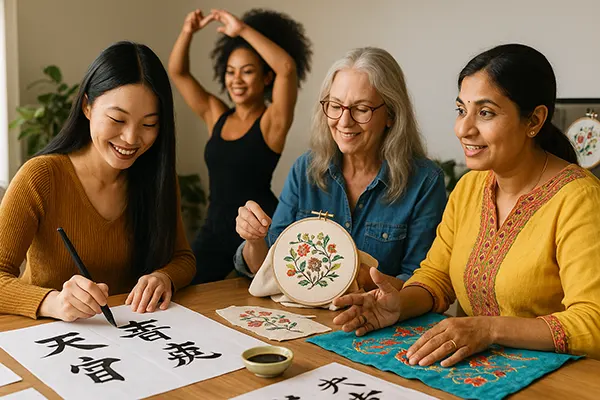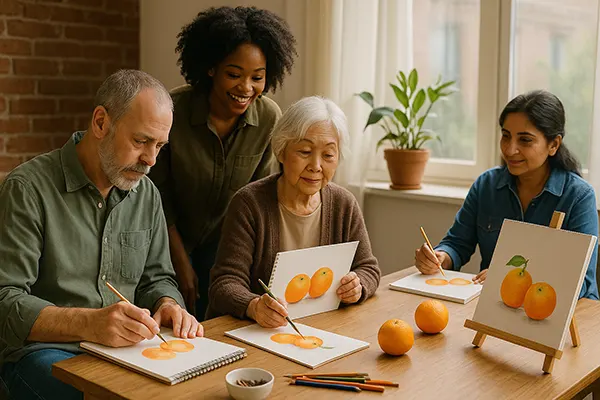
Cultural Non-Tourism: Online Courses by Female Masters Worldwide
In recent years, online learning has become more than just a way to acquire skills. It has also evolved into a cultural bridge, connecting people with traditions and artistic practices that were once limited to local communities. Female masters across the globe now share their expertise in embroidery, dance, calligraphy, and many other creative fields. This trend not only preserves cultural heritage but also offers women the opportunity to generate income and build international recognition for their work.
Learning Through Global Female Communities
Modern online learning platforms such as Domestika and Skillshare have opened doors for women artisans to showcase their knowledge to an international audience. These spaces give learners access to workshops in fields as diverse as Peruvian embroidery, Japanese calligraphy, and Indian classical dance, all guided by experienced female masters. The format allows students to learn at their own pace while still receiving authentic insights from cultural experts.
What makes these communities unique is their emphasis on inclusivity and cultural exchange. A person in Europe can now gain skills from a Peruvian textile artist without leaving their home, while simultaneously supporting the livelihood of the instructor. This has given rise to a new form of cultural non-tourism, where the journey happens through learning and interaction rather than physical travel.
Moreover, female-led courses often highlight personal stories and historical context behind each art form. This transforms the lessons from simple skill-building sessions into experiences that carry meaning, tradition, and connection. As a result, learners not only acquire practical abilities but also develop respect and appreciation for the communities behind them.
Domestika, Skillshare, and Local Initiatives
Domestika is one of the leading global spaces for creative education, featuring courses by female artists from across the world. From embroidery masters in South America to calligraphy experts in Asia, these classes showcase cultural artistry in modern formats. The platform provides high-quality video lessons, downloadable resources, and a strong community aspect where learners and teachers interact directly.
Skillshare, on the other hand, offers a broader creative learning experience. Its library includes courses on everything from contemporary dance to traditional crafts, with female creators increasingly gaining recognition. Skillshare’s model allows students to follow structured paths while exploring diverse disciplines taught by women with practical and professional experience.
In addition to these large platforms, local initiatives have also entered the online sphere. Many women’s studios, once limited to their geographic regions, now attract international audiences. A Peruvian embroidery collective or a Japanese calligraphy studio can build online courses and deliver them to thousands of learners worldwide. This trend has made cultural traditions more accessible while giving instructors economic independence.
Turning Knowledge into Income
For many women, teaching online has become a reliable source of income. Instead of relying solely on local demand, they can now reach global audiences eager to learn authentic skills. By recording courses or hosting live workshops, instructors can monetise their expertise while keeping ownership of their cultural narratives.
The monetisation process usually involves creating a course once and then making it available indefinitely, generating passive income. For example, a textile artist from Mexico can record a detailed series on weaving techniques and continue to earn money as long as learners enrol. Some masters also combine their teaching with sales of physical artworks or digital patterns, adding another income stream to their practice.
Beyond financial benefits, this activity gives women the ability to build professional reputations beyond their local communities. As more learners recognise their work, they are invited to collaborations, exhibitions, and cultural exchanges, reinforcing both their income and cultural visibility.
Examples of Successful Female Educators
One inspiring example is that of a Peruvian embroidery artist who built her reputation online by teaching traditional weaving patterns. Her courses not only provide learners with technical skills but also explain the cultural symbolism behind each stitch. This has attracted thousands of students worldwide and turned her craft into a sustainable business.
Another case is a Japanese calligraphy master who transitioned from running a small studio in Kyoto to offering digital lessons to an international audience. Through online teaching, she has preserved an ancient art form while making it accessible to people who may never have had the chance to visit Japan.
Similarly, female dancers from India have developed digital workshops in classical dance forms. These courses combine technical training with cultural storytelling, allowing learners to connect both physically and emotionally to the traditions. Their success shows how online teaching can protect cultural heritage while empowering women economically.

Cultural Exchange and Social Value
The value of cultural non-tourism extends far beyond personal skill development. When learners engage with online courses led by female masters, they participate in a form of cultural exchange that benefits both sides. Students gain authentic experiences, while instructors share their heritage and build stronger recognition of their traditions.
This process also strengthens the role of women in cultural preservation. Many of the traditions now taught online were historically passed down within families and communities. By adapting them to the digital environment, women ensure these practices remain alive and relevant in the modern world.
In addition, the global reach of these courses fosters respect for diversity and intercultural dialogue. It bridges distances by connecting people who may never physically meet yet share a passion for learning. This makes cultural non-tourism a valuable contribution to both education and social cohesion.
The Future of Female-Led Online Learning
As technology continues to advance, the role of women in digital education is set to expand further. The combination of video lessons, interactive sessions, and digital marketplaces gives female masters more opportunities to present their work to wider audiences. In 2025, platforms are expected to integrate artificial intelligence for better translation and accessibility, making cultural education even more inclusive.
Additionally, collaborations between international institutions and local female artists will likely increase. Museums, cultural centres, and non-profits are recognising the potential of digital courses as tools for cultural preservation and empowerment. This will bring more visibility and funding to women-led initiatives.
Ultimately, cultural non-tourism not only supports personal and professional growth but also strengthens communities. Female masters are shaping a digital ecosystem where knowledge, heritage, and creativity can travel freely, benefiting people across the globe.




